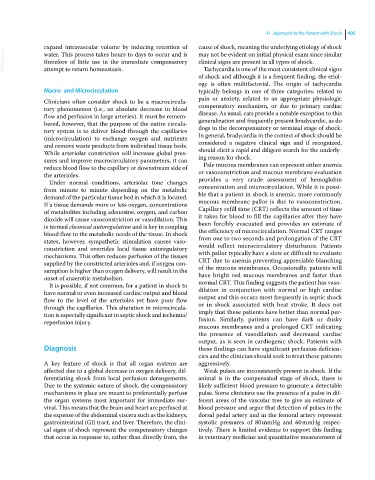Page 437 - Clinical Small Animal Internal Medicine
P. 437
41 Approach to the Patient with Shock 405
expand intravascular volume by inducing retention of cause of shock, meaning the underlying etiology of shock
VetBooks.ir water. This process takes hours to days to occur and is may not be evident on initial physical exam since similar
clinical signs are present in all types of shock.
therefore of little use in the immediate compensatory
Tachycardia is one of the most consistent clinical signs
attempt to return homeostasis.
of shock and although it is a frequent finding, the etiol
ogy is often multifactorial. The origin of tachycardia
Macro‐ and Microcirculation typically belongs in one of three categories: related to
Clinicians often consider shock to be a macrocircula pain or anxiety, related to an appropriate physiologic
tory phenomenon (i.e., an absolute decrease in blood compensatory mechanism, or due to primary cardiac
flow and perfusion in large arteries). It must be remem disease. As usual, cats provide a notable exception to this
bered, however, that the purpose of the entire circula generalization and frequently present bradycardic, as do
tory system is to deliver blood through the capillaries dogs in the decompensatory or terminal stage of shock.
(microcirculation) to exchange oxygen and nutrients In general, bradycardia in the context of shock should be
and remove waste products from individual tissue beds. considered a negative clinical sign and if recognized,
While arteriolar constriction will increase global pres should elicit a rapid and diligent search for the underly
sures and improve macrocirculatory parameters, it can ing reason for shock.
reduce blood flow to the capillary or downstream side of Pale mucous membranes can represent either anemia
the arterioles. or vasoconstriction and mucous membrane evaluation
Under normal conditions, arteriolar tone changes provides a very crude assessment of hemoglobin
from minute to minute depending on the metabolic concentration and microcirculation. While it is possi
demand of the particular tissue bed in which it is located. ble that a patient in shock is anemic, more commonly
If a tissue demands more or less oxygen, concentrations mucous membrane pallor is due to vasoconstriction.
of metabolites including adenosine, oxygen, and carbon Capillary refill time (CRT) reflects the amount of time
dioxide will cause vasoconstriction or vasodilation. This it takes for blood to fill the capillaries after they have
is termed chemical autoregulation and is key in coupling been forcibly evacuated and provides an estimate of
blood flow to the metabolic needs of the tissue. In shock the efficiency of microcirculation. Normal CRT ranges
states, however, sympathetic stimulation causes vaso from one to two seconds and prolongation of the CRT
constriction and overrides local tissue autoregulatory would reflect microcirculatory disturbance. Patients
mechanisms. This often reduces perfusion of the tissues with pallor typically have a slow or difficult to evaluate
supplied by the constricted arterioles and, if oxygen con CRT due to anemia preventing appreciable blanching
sumption is higher than oxygen delivery, will result in the of the mucous membranes. Occasionally, patients will
onset of anaerobic metabolism. have bright red mucous membranes and faster than
It is possible, if not common, for a patient in shock to normal CRT. This finding suggests the patient has vaso
have normal or even increased cardiac output and blood dilation in conjunction with normal or high cardiac
flow to the level of the arterioles yet have poor flow output and this occurs most frequently in septic shock
through the capillaries. This alteration in microcircula or in shock associated with heat stroke. It does not
tion is especially significant in septic shock and ischemia/ imply that these patients have better than normal per
reperfusion injury. fusion. Similarly, patients can have dark or dusky
mucous membranes and a prolonged CRT indicating
the presence of vasodilation and decreased cardiac
output, as is seen in cardiogenic shock. Patients with
Diagnosis these findings can have significant perfusion deficien
cies and the clinician should seek to treat these patients
A key feature of shock is that all organ systems are aggressively.
affected due to a global decrease in oxygen delivery, dif Weak pulses are inconsistently present in shock. If the
ferentiating shock from local perfusion derangements. animal is in the compensated stage of shock, there is
Due to the systemic nature of shock, the compensatory likely sufficient blood pressure to generate a detectable
mechanisms in place are meant to preferentially perfuse pulse. Some clinicians use the presence of a pulse in dif
the organ systems most important for immediate sur ferent areas of the vascular tree to give an estimate of
vival. This means that the brain and heart are perfused at blood pressure and argue that detection of pulses in the
the expense of the abdominal viscera such as the kidneys, dorsal pedal artery and in the femoral artery represent
gastrointestinal (GI) tract, and liver. Therefore, the clini systolic pressures of 80 mmHg and 60 mmHg respec
cal signs of shock represent the compensatory changes tively. There is limited evidence to support this finding
that occur in response to, rather than directly from, the in veterinary medicine and quantitative measurement of

